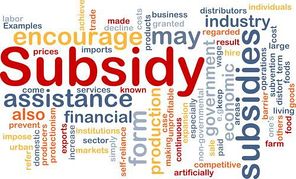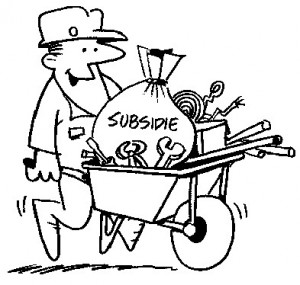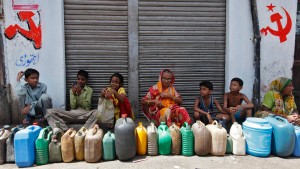In this blog post, Pramit Bhattacharya, a student of Damodaram Sanjivayya National Law University tries to examine if subsidies can be eliminated in a country like India, given its socio-economic conditions.
People who are in favor of subsidies give the argument that due to the subsidies provided, more goods are services are being produced in that particular sector, and more employment opportunities are being created. But the point which is almost never acknowledged is the benefits the society would have reaped if the money would have been spent otherwise or left in the pockets of the taxpayers.
Opportunity cost of subsidies
Here the concept of opportunity cost comes in. This concept of opportunity cost is instinctual, choosing between X and Y. In economic terms opportunity cost can be defined as expenditure in its highest alternative use. A small example of it can be given. Suppose a person has Rs 1000 in his pockets and spends Rs 800, on a party night that Rs 800 is no longer to buy him necessities like food or clothes. Now, on a bigger scale, a very similar example can be given. Suppose the government spends Rs 1000 crore in constructing a bridge that a very few number of people will use, that money is not available anymore to be spent on other services like healthcare, education and other policies which are on high priority. The economy is made up of a feedback mechanism and in such mechanism the parallel between households and the governments in not perfect and foolproof. But when there is a budget constraint, all spending decisions are traded off. In an ideal situation, the aim of the government is to plan its expenditure in such a way that the return to the society is roughly same as the spending. But this balanced is disordered by subsidies.
Subsidies not only hurt the general governance of the society, but it also impacts the overall economic structure. Very recently, The World Trade Organization’s 2015 in its Nairobi Ministerial decided to scrap subsidies provided on cotton exports. Reacting to that, the Indian Government has stated that the eliminations of the subsidy will benefit Indian exports. According to the government, the scrapping of such subsidies creates a level playing field.[1] These statements reinforce the fact that elimination of subsidies helps in a larger way too. Talking about subsidies on fuel, these subsidies also cost Oil Marketing Companies a lot. According to a report, the under-recovery incurred by OMCs in the first quarter of the financial year 2014-15 itself was Rs 28, 690.74 crore.[2] Contrary to popular belief, the duty and the excise on fuels is not much. The price of fuels like petrol and diesel keeps on going up due to the subsidies provided on them.
The biggest problem of subsidies is that they decrease the surplus in a disguise. For example, consider a hydropower plant. The water used to produce electricity is also utilized by a farmer to irrigate his field. Now, when a cubic meter of water goes through the turbine to generate electricity, it has much higher value than irrigating the farmer’s crops. The government then comes up with a subsidy policy which allows him to pump out water from the reservoir at a minimal cost. This results in diverting the water from the water source to a lower value use, which in turn shrinks the surplus and the economy as a whole generates a smaller surplus.
Withdrawing of subsidies leads to a positive growth of the economy. And finally, the Indian government is also treading the lines of economic growth. The BJP government, after 18 months in power, withdrew the subsidy policy on LPG for those with an income of more than Rs 10 lakh. This is a wonderful step which will give a shot in the arm to the Indian Exchequer. The government made an LPG subsidy payout of Rs 40, 551 crore in the year 2014-15.[3] The government began the “Give it up” campaign urging well-off people to give up their subsidies on LPG cylinders under which some 57 lakh people opted out of their LPG subsidies.[4] The numbers were not really satisfactory, and hence, the government decided to go a step further by removing subsidization based on the income of households.
| Category | FY14 (Actuals) | FY15 (Revised estimates) | FY16 (Budget estimates) |
| Urea | 38,038 | 50,300 | 50,500 |
| Decontrolled fertilizers | 29,301 | 20,667 | 22,469 |
| Food | 92,000 | 122,676 | 124,419 |
| Petroleum | 85,378 | 60,270 | 30,000 |
| Interest | 8,137 | 11,147 | 14,903 |
| Other | 1,778 | 1,632 | 1,520 |
| Total | 254,632 | 266,692 | 243,811 |
Government subsidies payment in Rs crore[5]
Effect of subsidies on efficiency
Granting of subsidies has its first order or static effects. Economic experts often say that subsidies create economic distortions, especially the subsidies which are used to promote any particular sector or industry. In such cases, resources are more often than not, diverted to less productive use, thereby reducing the economic efficiency. Those who are in favor of subsidies counter this view by contending that these subsidies serve other redistributive goals. But again what they miss out is that providing subsidies may have external effects, which were not anticipated.
Dynamic Effect of Subsidies
Over time, the benefit reaped from the subsidy policies capitalize into the least elastic form of production. Subsidies are transitional. It helps only that section of the society who can immediately take the benefits of the subsidies. The successor of these people ends up paying a higher price for the subsidized product.
The beneficiaries of subsidy programs become socially trapped also. Matters become worse when subsidization is used to support employment. Due to the subsidies being provided, people are more inclined to enter the profession, and mobilization in that form of profession stagnates. The amount of dependence on subsidies becomes an obstacle when it comes to making new policy reforms.
Distribution of subsidies
It is of no doubt that some subsidies do benefit some disadvantaged groups. But even in such cases, these subsidies benefit companies and richer people more. Ironically, the distribution consequences of subsidies are often the opposite of what had been really intended. The passage between the government and those who are intended recipient of the subsidy benefits is often more like a stream rather that a pipe which provides ample opportunity to other to dip themselves in the stream and reap the benefits of it before the actual intended recipient.
Effect on Environment
On the outset, subsidy policies may not harm the environment intentionally. But again, they do harm the environment in disguise. When talking about “environmentally harmful subsidies”, it often means subsidies which provide high incentives to heavy production, consumption, and transportation, which harm the environment. For example, if high subsidies are given in the fishery industry, to promote offshore fishing, it will lead to the depletion of important fishery stock. Talking about other industries, subsidies which offer incentives for higher production and consumption often lead to an increased amount of waste emission and discharge.
Political Motive and Subsidies
Various shortcomings of providing subsidies have been mentioned above. It is evident that the subsidy policies do more damage than good. Still why do the government bring into play these kinds of policies? These answers can be found in political motives of the ruling government. They are often motivated to provide subsidies to a specific section of the society who may increase their vote banks.
Finally, the bureaucracy itself can present an obstacle. Government ministries rarely admit to having a vested interest in the continuation of the support programs they administer, but it is hard to imagine total disinterest being the norm. More subtly, the bureaucratization process often feeds a pervasive notion that the subsidized activity forms part of the natural order of things. Subsidies thus metamorphosize into entitlements, and any attempt to curb them becomes politically hazardous.[6]
An introspective approach regarding subsidies will lead to the fact that one of the main causes of India’s fiscal problems has been subsidies. There is no alternative source that compensates the losses accrued due to subsidies. In such a scenario, the question arises whether subsidies should be completely done away with?
Like every coin that has two sides, this question can also be answered in two perspectives. One perspective is that subsidies on food, fuel, etc. should be completely removed. This can be done by hiking the price in these sectors marginally and then remove subsidies in a phased manner. This would reduce the shock of elimination of the policy at one go. Over time, this would help the government in maintaining healthier fiscal balances and using its money to promote growth in key areas in the country. This, in turn, would help promote investment interests of the private sector as well as bring in long-term foreign capital. The combined effect would be long-term growth for the country.
The other view is that in a country like India, with a population of more than 120 crore, and half of them living in poverty, it is impossible to eliminate subsidies. Providing subsidies have become a part and parcel of the Indian economic structure. The missing link is a proper structure of distribution of subsidies between the government and the actual intended recipients. If the process is made water-tight, subsidies will cease to be a burden on the economy of the nation.
The fact that cannot be negated is that a significant number of people in the country are poor, and they do need governmental aid. On the other hand, the fact that subsidies are a burden also can’t be negated. But by keeping the prices low in a fabricated manner by providing subsidies, the government is not doing any good to the economy of the country. Therefore, the need of the hour is to get on with new policy reforms and start eliminating subsidy policies in a phased manner.
Footnotes:
[1]http://economictimes.indiatimes.com/news/economy/policy/elimination-of-export-subsidies-on-cotton-beneficial-for-indian-exports-says-government/articleshow/52013264.cms
[2]http://pib.nic.in/newsite/PrintRelease.aspx?relid=107321
[3]http://www.financialexpress.com/article/economy/tax-payers-earning-over-rs-10lyr-not-to-get-subsidised-lpg/184675/
[4]http://www.firstpost.com/business/ending-lpg-subsidy-for-the-well-off-a-welcome-move-will-kerosene-urea-follow-soon-2563840.html
[5]data:application/octet-stream;charset=utf-8,Category%2CFY14%20(Actuals)%2CFY15%20(Revised%20estimates)%2CFY16%20(Budget%20estimates)%0AUrea%2C38038%2C50300%2C50500%0ADecontrolled%20fertilisers%2C29301%2C20667%2C22469%0AFood%2C92000%2C122676%2C124419%0APetroleum%2C85378%2C60270%2C30000%0AInterest%2C8137%2C11147%2C14903%0AOther%2C1778%2C1632%2C1520%0ATotal%2C254632%2C266692%2C243811 – [5]http://www.firstpost.com/business/ending-lpg-subsidy-for-the-well-off-a-welcome-move-will-kerosene-urea-follow-soon-2563840.html
[6]https://www.iisd.org/gsi/effects-subsidies
 Serato DJ Crack 2025Serato DJ PRO Crack
Serato DJ Crack 2025Serato DJ PRO Crack












 Allow notifications
Allow notifications



